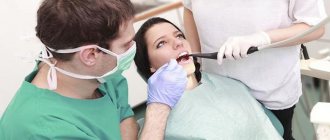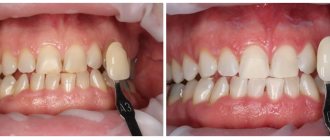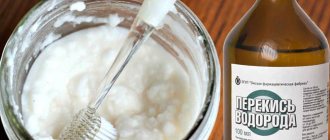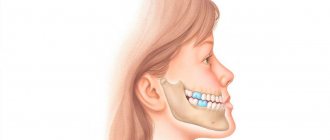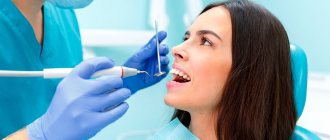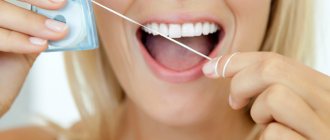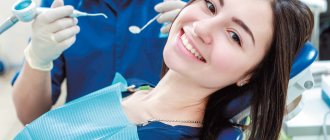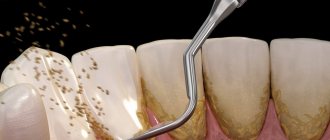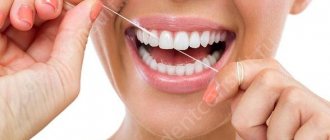From this article you will learn:
- how is tartar formed?
- Is it possible to remove tartar at home,
- which will help reduce the amount of dental plaque.
The article was written by a dentist with more than 19 years of experience.
The ability to remove plaque at home will depend on its type. For example, you can use special products, which we will discuss below, to remove not too massive pigment plaque that occurs in smokers and lovers of too strong tea or coffee. As for removing plaque, using a regular toothbrush and toothpaste only removes soft microbial plaque well. Removing partially mineralized plaque, and especially tartar, requires the use of special means.
With irregular oral hygiene, soft microbial plaque that is not removed from the teeth in time begins to gradually mineralize (absorbing calcium salts from saliva), turning into hard tartar. It will no longer be possible to remove tartar at home if it is completely mineralized or large in size. But if you have a smoker’s pigment plaque, or the microbial plaque is only partially mineralized and therefore has a loose consistency, then for these cases there is one fairly effective method.
Hard dental plaque: photo
Such dental deposits (tartar) as in Fig. 1-3 can only be removed at the dentist by signing up for an ultrasonic teeth cleaning procedure. Only partially mineralized stone, which is small in size and has a loose consistency, can be removed at home - and all this applies only to supragingival dental plaque. Subgingival tartar, which is present in almost all patients with gum disease, can only be removed by a dentist.
So what can replace a visit to the dentist if you have smoker plaque or a small amount of tartar. A combination of an Oral-b electric brush and a special teeth polisher will help us with this. Let us remind you that Oral-b toothbrushes are made on the principle of a dentist’s instrument, which the doctor uses to remove plaque and the remains of hard dental deposits. You will probably remember how, after the ultrasonic cleaning procedure, the doctor polished your teeth with a rotating attachment with bristles and polishing paste. And we will do the same.
So, for this we need:
- electric brush from Oral-b,
- special toothpaste.
How to remove plaque from teeth?
The enamel becomes damaged over time and microscopic cracks and chips form on the hard surface. It is here that favorable conditions are created for the accumulation of food debris and the proliferation of bacterial flora. Even thorough cleaning and medicinal paste are not always able to cope with the elimination of the pathological process.
Over time, the formation hardens - tartar forms, which cannot be removed at home without the help of a qualified dentist.
To effectively solve the question “How to remove plaque from teeth?”, you should accurately determine the localization of the pathological process:
- The dentogingival pathological process develops on the crown near the gums.
- The proximal option is the accumulation of deposits at the contact points of the side walls.
- Subgingival - visually it is extremely difficult to determine. The pathological process occurs under the gums, leading to the development of complications in a short time.
How to remove black plaque on teeth?
Black spots are formed due to the abuse of coffee, black tea, alcoholic beverages and narcotic substances. It is formed over many years (sometimes throughout life). If diagnosed in childhood, it is often of a fungal nature (the cause is dysbacteriosis). Often occurs after severe viral infections.
How to remove black plaque on teeth:
- Laser removal is the most effective and gentle method that allows you to get rid of the defect for a long time. The procedure is absolutely painless, does not damage the enamel, and avoids bleeding.
- Ultrasonic cleaning is the method of choice for weakened enamel. It acts very gently and removes even hard deposits (including tartar).
- Home remedies – regular use of medicated pastes with high fluoride content.
- An excellent prevention is regular consumption of fresh fruits and vegetables (carrots and apples are especially useful). These products provide significant oral health benefits by preventing staining and improving gum circulation.
How to remove yellow plaque on teeth?
Yellow deposits on the surface of the enamel are the most benign; they can be easily removed and rarely transform into stone; they have a loose structure. Regular brushing with a stiff brush and whitening pastes will help effectively remove deposits and give your smile a sparkling whiteness.
The main condition is to purchase only professional paste in pharmacies or specialized departments of stores. You cannot use medicinal pastes all the time - a monthly course, once every six months, is enough.
How to remove yellow plaque on teeth using home remedies? You can use regular baking soda - thoroughly clean your mouth with the product for 2-3 minutes before your usual brushing. To avoid damaging the enamel, this method should be used once a week.
Removing tartar: conclusions
- Without the intervention of a dentist, small hard dental deposits, as well as not too pronounced smoker’s pigment deposits, can only be dealt with by either professional dental products such as “Detartrine-Z” or toothpaste with an RDA 200 index. These products should be used with an Oral electric toothbrush -bi (in low speed mode), preferably no more than once every 10 days.
The effectiveness of such a complex will depend on your level of hygiene. After all, if you still don’t brush your teeth after every meal or don’t use dental floss, your mouth will continue to experience intensive formation of tartar and pigmented plaque. For information on how to properly brush your teeth, read the article: → “Prevention of dental and gum diseases” - Traditional “grandmother’s” remedies are completely powerless against tartar. Due to its very high strength, tartar cannot be dissolved by any available means without causing irreparable damage to the teeth and oral mucosa. Toothpastes often use pyrophosphates, bromelain, and polydone to loosen plaque. These components are safe for teeth, but they are effective precisely for preventing the formation, and not for dissolving already formed tartar.
Remember that there are many recipes on the Internet that are completely ineffective and even those that can cause irreparable damage to dental health. Unfortunately, most of these recipes are devoid of any common sense and are written by people who have nothing to do with medicine. We hope that our article was useful to you!
Sources:
1. Dental education of the author of the article, 2. Based on personal experience as a periodontist, 3. https://oralb.com/, 4. https://www.presi-dent.ru/, 5. https://www.lacalut.ru/.
How to remove plaque between teeth?
Professional cleaning techniques will help solve the problem of removing plaque between teeth:
- The most accessible and safest method of eliminating the problem is ultrasonic cleaning of interdental spaces. This method removes existing deposits, kills pathogens and perfectly polishes the enamel, preventing the development of stains for a while.
- Treatment using the Air Flow technique. The essence of the procedure is to apply a mixture of water, air and soda to the surface of problem areas. Polishing occurs under pressure, plaque is removed even from hard-to-reach places.
- Laser cleaning is an expensive but effective method that does not damage the enamel and carefully removes deposits from the surface of the teeth. The duration of the effect is about a year, it is possible to repeat the procedure if the process is running.
Hygiene products for combating mineralized deposits at home
You can remove plaque yourself without expensive dental procedures.
The following effective remedies can be used at home:
Special pastes
Contains pyrophosphates, abrasive and grinding components, bromelain and papain enzymes, as well as zinc compounds.
Under their influence, the structure of the stones loosens and easily peels off from the enamel. The presence of triclosan helps suppress the growth of pathogenic microorganisms and ensures normal microflora in the oral cavity.
Experts recommend:
- Jason Sea Fresh. It has a complex effect: it allows you to effectively clean teeth from stone, polishes the enamel, strengthens the structure of the bone tissue of the teeth, and prevents the formation of repeated deposits. Thanks to its natural composition, it has anti-inflammatory and antiseptic effects. The price is within 565 rubles.
- Lacalut White&Repair. RDA 120 abrasiveness. Suitable for removing tartar on sensitive teeth. Provides additional saturation of enamel with mineral components. Price 210 rubles.
- PRESIDENT White Plus. Contains a high abrasive index, which ensures the removal of hard tartar. Has a gentle effect on tooth enamel and periodontium. Cost 135 rubles.
Jason Sea Fresh
Lacalut White&Repair
PRESIDENT White Plus
Toothbrushes
At home, you should periodically brush your teeth with the following types of brushes:
- Electric with built-in generator. It provides broadcasting of an oscillatory wave, which allows you to remove mineralized deposits in easily accessible places.
- Electric brush with a rotating head. The intensity of rotation and pulsation of the device ensures partial splitting and removal of semi-hardened plaque even in hard-to-reach places.
Other hygiene products
For more thorough teeth cleaning, the following methods are used:
- Irrigator. A special device for oral hygiene. Helps thoroughly clean the entire surface of the teeth, even in the most inaccessible places. The device is intended for the use of rinses with therapeutic and preventive effects.
- Dental floss. Helps clean plaque in the narrowest interdental spaces. It is recommended to use unwaxed floss with antibacterial impregnation and special microcrystals that polish tooth enamel.
- Liquid for stone removal. To maintain proper oral hygiene, rinses are used that effectively clean the surface of the teeth. It is also recommended to use special liquids to indicate plaque. This will allow you to identify the stone and remove it completely, carrying out a more thorough cleaning.
Irrigator
Mouthwash
Dental floss
How to remove plaque on teeth from cigarettes?
The most common cause of brown spots is smoking.
The pigment contained in tobacco turns the enamel yellowish-brown. Many smokers are interested in how to remove plaque from cigarettes on their teeth. A course of use of whitening agents (special gels or strips), which are applied to the surface of the teeth immediately after brushing, effectively helps combat the characteristic yellowness. Baking soda and activated carbon powder are suitable as a mild abrasive. Fresh lemon juice and hydrogen peroxide can clear mild yellow stains. These methods are allowed to be used no more than once a week.
Tea tree oil is considered an excellent whitening agent that also has an antiseptic effect. After regular brushing, place a couple of drops of oil on the brush and carefully walk until you feel slightly numb. After the procedure, rinse your mouth thoroughly with water.
Basic concepts, localization sites, etiology and signs
Tartar consists of a layer of calcium, phosphate and iron salts, food debris, dead cells and bacteria
One of the most common dental problems with which patients turn to doctors is the presence of tartar.
This is a pathological dense deposit on the surface of the teeth.
It consists of a layer of calcium, phosphate and iron salts, food debris, dead cells and bacteria.
Taking into account the location of dental stones, they are classified into:
- Supragingival. They form on the front teeth on the inside of the lower jaw or on the outside of large molars. May also appear on dentures.
- Subgingival. They are localized in the periodontal pockets of any tooth. They are characterized by a dark color and increased hardness.
The main reasons for the appearance of such deposits include:
- Insufficient hygiene
- Unbalanced diet
- Changes in the structure and properties of saliva
- Development of cervical caries
- Curvature of the dentition
- Hereditary predisposition
- Immune system diseases
- Chronic foci of infection
- Systematic smoking
- Periodontal inflammation
In addition to the visual manifestation, large dental stones can manifest themselves in the form of the following signs:
- Pain when eating food
- Hypersensitivity of the external protective shell of the coronal part of the teeth
- Periodontal bleeding
- Excessive congestion of blood vessels and swelling of the gums
- Manifestations of unpleasant odor from the mouth
- Mechanical damage to the tongue due to mineralized deposits
Important! If you experience the slightest signs of tartar development, you must urgently seek qualified help from specialists. Ignoring treatment for this pathology can lead to serious dental complications.
How to remove plaque from a child’s teeth?
With ordinary white or yellowish plaque, the child’s mouth does not require professional cleaning. In this case, fragile children's enamel requires regular and careful care.
If black or brown spots appear, you should seek help from your dentist. How to remove plaque from a child’s teeth?
- Ultrasonic cleaning effectively removes even intense plaque. For children, the procedure is performed under local anesthesia. For babies under one year of age, manipulation is contraindicated.
- Blasting using abrasives (soda) is permitted from the age of seven. In case of inflammatory processes in the oral cavity and general chronic diseases (especially during exacerbations), the procedure is contraindicated.
- The manual cleaning method is used in cases where ultrasonic or jet treatment is not possible. A professional set of tools is used, with which the dentist manually cleans off the formations.
During professional cleaning, plaque is removed from gum pockets
At first glance, pockets in the gums may not be noticeable. If their depth is up to 1–2 mm, they do not cause concern. But with age, the gum line drops a little, and the neck of the tooth (root part) is exposed. Plaque accumulates in the pocket, causing inflammation.
Cleaning gum pockets is a separate treatment procedure. But with professional dental hygiene, prevention is carried out: Air Flow removes everything that has begun to accumulate in the pockets, preventing them from deepening.
Professional hygiene removes plaque from gum pockets
How to remove plaque from the inside of teeth?
Deposits on the inner surface are formed as a result of the accumulation of food debris and harmful bacteria, which multiply intensively, destroying the enamel as a result of their vital activity. If cleansing procedures are not carried out in a timely manner, the process spreads to the gums and bone structures of the jaw, leading to severe pathologies and premature tooth loss.
How to remove plaque from the inside of teeth? It is important to use an electric toothbrush regularly, brushing your mouth at a 45-degree angle. You can enhance the healing effect of the paste using special ultrasonic brushes.
As traditional methods, you can consider the method of cleansing the oral cavity using crushed activated carbon, a mixture of baking soda and 3% hydrogen peroxide. But this method is absolutely not suitable for weakened enamel.
What not to do?
If the structure of tartar is hard, then it is impossible to remove it yourself. Therefore, under no circumstances should you pick with a hook or pen in an attempt to remove stone deposits. Both enamel and gums will be damaged. A needle, a nail file, sandpaper - all these are useful things for a hobby, but not for treatment. According to statistics, 64% of people, afraid of finding themselves in the dental chair, resort to such manipulations at home. That is why you so often see people with a pirate smile, which you cannot look at without shuddering.
If plaque has formed in a child, then in no case should you use treatment methods that are used for adults. Salt and vinegar are not suitable for it, like many other ingredients.
All folk methods are widely known, but they must be applied individually, wisely and carefully. There are people intolerant to honey, radishes, and nuts. In their case, the treatment will cause an allergic reaction. Sometimes the harm is greater than the effect of treatment. So if the problem really bothers you, go see a doctor instead of using plantain.
If tartar appears again despite attempts to get rid of it, this means that something is wrong with the body. This means it’s time for you not to see a fortune teller, but to see a doctor, and immediately. But some people and even doctors believe that tartar can fall off on its own. Is it true?
The fastest and most extreme ways to get rid of plaque
Three “extreme” ways:
Fir oil
According to an old recipe, it helps get rid of plaque and relieves inflammation of the gums. Soak a cotton swab with fir oil. Then wipe the problem area or make a compress;
Regular clay
It doesn’t matter which one, use it as toothpaste. It will create an alkaline environment in the oral cavity. While cleaning, add diluted clay to the brush 2 times a day.
Honey applied to a cotton swab
Polish the surface with a cotton swab dipped in honey.
Any natural decoction has a mild effect, so each procedure must be repeated to achieve a noticeable result. Already within the first few times, the dynamics of the presence of the stone may soften, which will also facilitate removal during a visit to the dentist.
Decoctions from plants to remove plaque
The best removal methods include folk remedies.
You can prepare a special decoction and other medicines to remove the stone yourself. For example, rinsing teeth with honey is popular. You will need to dissolve 1 spoon of the sweet product in a glass of water and rinse for 5 minutes every day. Sage decoction demonstrates effectiveness in dental treatment. You will need to take 1-3 tablespoons of the herb, pour a glass of hot water and leave for 15 minutes. Wait until the resulting broth cools down, then you need to rinse 3 times a day.
Is it painful to remove subgingival calculus?
When cleaning stone in subgingival pockets, in most cases, mild pain occurs. This is explained by the fact that the stone is attached directly to the periodontium. Even a thin layer of enamel significantly reduces tooth sensitivity; it simply does not exist in the subgingival zone. Therefore, discomfort during the procedure is a completely reliable and expected phenomenon.
Subgingival stone must be removed, as it causes the development of putrefactive bacteria and contributes to the occurrence of caries and inflammatory diseases of the oral cavity.
